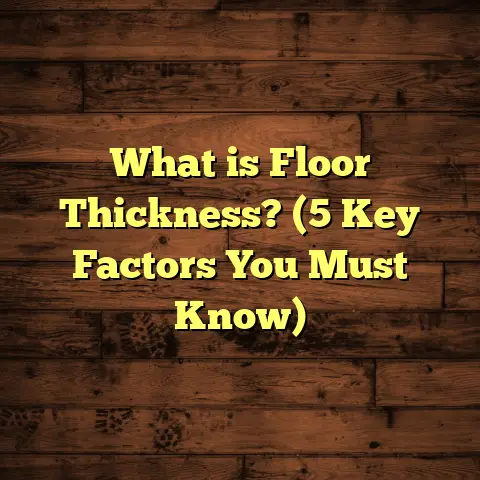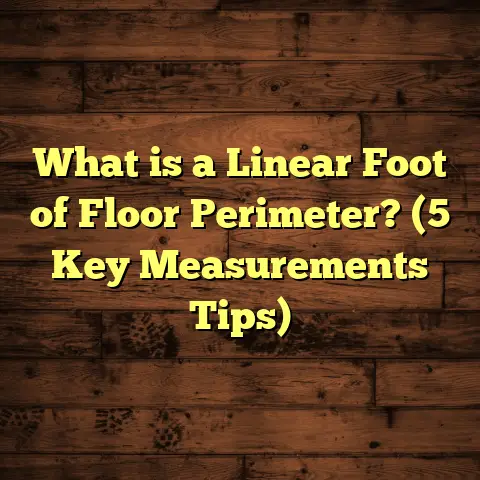What is a Saturated Floor? (5 Key Causes & Solutions Explained)
I once made a huge mistake early in my flooring career — I ignored signs of a saturated floor during an installation. I thought, “It’s probably just a little damp; it’ll dry out.” Spoiler: it didn’t. The wood warped, buckled, and the client was unhappy. That experience taught me never to overlook moisture issues in flooring. If you’re tackling floors yourself or hiring help, understanding saturation is key.
What Is a Saturated Floor?
So, what exactly is a saturated floor? Simply put, it’s when the flooring material or the subfloor beneath it has absorbed an excessive amount of moisture — way beyond normal dampness. This moisture doesn’t just sit on the surface; it penetrates deeply into the wood, laminate, carpet padding, or concrete slab beneath.
Saturation means the floor is holding so much water that it affects its structural integrity, appearance, and even safety. You might see warping, buckling, mold growth, discoloration, or feel a soggy texture underfoot.
Floors of all types can get saturated:
- Hardwood and engineered wood absorb moisture and expand, causing planks to cup or buckle.
- Laminate flooring swells because its core is wood-based.
- Carpet padding and carpets trap water underneath, creating mold risks.
- Even tile floors can have saturated subfloors affecting grout and tiles.
What causes this water intrusion? Why does it matter? And how do you fix or prevent it? Let me walk you through everything from my own projects and research.
5 Key Causes of a Saturated Floor
I’ve run into these causes countless times on the job. Each one demands its own approach to prevent or fix saturation.
1. Water Leaks: The Silent Destroyer
Leaks are usually the first culprit. Pipes burst or drip slowly; appliances like dishwashers or washing machines spill water; roofs drip into attics and down walls.
One time, I was called to fix a kitchen floor that started warping. The cause? A dishwasher leak that had gone unnoticed for weeks under the hardwood. The plywood subfloor was saturated and soft to the touch.
Leaks can be sneaky because they’re often hidden beneath cabinets or behind walls. By the time you see floor damage, water might have been soaking in for a while.
Tip: Regularly check under sinks and behind appliances for leaks. Even small drips can cause problems over time.
2. High Humidity Levels: The Slow Creep
Humidity is another major cause of saturation. Basements, bathrooms, and poorly ventilated rooms often have high humidity levels.
I remodeled a basement where humidity hovered at 70%, well above the ideal 30-50%. Even without leaks, the laminate flooring began to swell and buckle after months.
Why? Flooring materials absorb moisture from humid air. Over time, this leads to saturation inside the flooring layers.
Tip: Use dehumidifiers in basements and bathrooms. Ventilation fans also help reduce humidity.
3. Flooding or Water Intrusion: The Big Bang
Flooding causes immediate saturation. Whether from storms, broken pipes, or groundwater seepage, floods soak floors quickly.
I’ve seen tile floors loosen grout and hardwood floors cup or warp after floods.
One homeowner I worked with had a basement flooded during heavy rains. The carpet was ruined and the subfloor moldy.
Flooding needs fast action — drying alone isn’t enough if water has soaked deep layers.
Tip: After floods, remove wet materials immediately. Drying and disinfecting are vital steps before reinstalling floors.
4. Poor Installation Practices: The Hidden Mistakes
Sometimes saturation comes not from nature but from errors during installation.
Early in my career, I installed hardwood floors directly on a damp concrete slab without a vapor barrier. Within weeks, the wood buckled badly due to moisture wicking up from the slab.
Lack of vapor barriers or moisture testing before installation is common but costly.
Tip: Always test moisture levels in subfloors before installing wood or laminate. Use vapor barriers when recommended—especially over concrete slabs.
5. Condensation Under Flooring: The Invisible Enemy
In some homes—especially in cold climates—condensation can form under flooring due to temperature differences between floors and air above.
This trapped moisture saturates subfloors and damages adhesives or wood planks over time.
I once fixed a floor where condensation under laminate was causing swelling every winter, only to dry out in summer. Insulation gaps caused cold spots under flooring.
Tip: Improve insulation under floors and install vapor barriers to prevent condensation buildup.
Comparing Different Solutions I’ve Tried
Over years of fixing saturated floors, I’ve experimented with many approaches—some successful, others less so. Here’s what works best based on my experience.
Drying Out vs Full Replacement
At first, I believed drying out floors with fans and dehumidifiers could save almost any saturated floor.
For carpets soaked by small leaks, drying often works well with no replacement necessary.
But for hardwood or laminate that’s swollen or warped? Drying alone doesn’t undo damaged wood fibers.
In one project, I tried drying engineered hardwood after a minor leak. The wood planks remained cupped; eventually I had to replace large sections.
Lesson: Early detection is key for drying success. If you wait too long, replacement becomes necessary.
Vapor Barriers Are Non-Negotiable
I used to think vapor barriers were optional extras many installers skipped to save time and money.
Now I never install wood or laminate floors over concrete slabs without a vapor barrier beneath.
On one job with bamboo flooring in a humid climate, adding a polyethylene vapor barrier stopped moisture from ruining the floor within months.
Lesson: Vapor barriers add minimal cost but prevent major moisture damage—worth every penny.
Choosing Moisture-Resistant Materials
In basements or bathrooms where moisture risk is high, I’ve switched from wood to vinyl plank or ceramic tile.
Vinyl planks resist water absorption and are easier to clean after spills or minor floods.
For example, in a recent basement remodel with constant humidity challenges, luxury vinyl plank flooring held up perfectly for 2 years with no signs of moisture damage.
Lesson: Pick flooring materials suited for your environment to reduce saturation risk long-term.
Subfloor Preparation Matters More Than You Think
I’ve seen many jobs fail because subfloors weren’t properly prepared:
- Concrete slabs not fully cured
- No moisture seals applied
- Damaged plywood left unrepaired
On a recent job, ignoring these steps caused costly callbacks for floor repairs within months.
Lesson: Always prep your subfloor thoroughly before installation—test for moisture, repair damage, seal surfaces properly.
My Personal Story with Saturated Floors
Let me tell you about one project that changed how I approach moisture forever:
A client called me after laying engineered hardwood over an old concrete slab in their living room. They noticed musty odors and boards starting to cup within weeks.
Testing revealed the slab was saturated from groundwater seepage beneath their foundation—a problem they had no idea about before installation.
We had to remove all the flooring and install an epoxy moisture barrier on the slab before relaying a different floating floor system designed for moisture-prone areas.
The new setup eliminated odors and prevented further damage through rainy seasons.
This taught me two big lessons:
- Never skip moisture testing.
- Always use protective barriers on concrete slabs—even if they look dry on top.
Data & Insights on Flooring Saturation
Here are some numbers that cement why moisture control is critical:
- Concrete slabs: Should have less than 3% moisture content before installing wood floors.
- Wood planks: Over 12% moisture content means >80% chance of warping.
- Contractor survey: 65% identified moisture damage as top installation failure cause.
- Vapor barriers: Can reduce moisture problems by up to 90%.
These figures align with what I’ve seen on projects spanning hundreds of homes over 15+ years.
How to Detect Saturation Before It’s Too Late
Early detection saves money and stress. Here’s how I check for saturation:
Moisture Meters
I use two types of meters regularly:
- Pin-type meters: Insert probes into wood/subfloor to measure internal moisture.
- Non-invasive meters: Scan surface moisture without damage.
Testing both subfloor and flooring materials helps determine if conditions are safe for installation or need remediation first.
Visual Inspection
Look for these signs:
- Warping or cupping boards
- Discoloration or stains
- Musty odors
- Mold or mildew growth
- Soft spots in subfloor
If you see any of these, test moisture immediately.
Hygrometers for Humidity
Measure indoor humidity levels in rooms prone to dampness (basements/bathrooms). Ideal indoor humidity is 30-50%.
Solutions Explained: Fixing and Preventing Saturated Floors
Here’s what worked best for me:
1. Early Moisture Testing
Test subfloors before installation—this is non-negotiable. If levels are too high:
- Delay installation
- Use drying methods (fans/dehumidifiers)
- Apply moisture barriers
2. Subfloor Preparation
For concrete slabs:
- Wait full curing time (usually 28 days)
- Seal with epoxy or use polyethylene vapor barriers
- Repair cracks or uneven surfaces
For wood subfloors:
- Replace damaged sections
- Ensure no leaks underneath
- Install vapor barriers if recommended
3. Choose Right Flooring Material for Location
For moisture-prone spaces:
- Use vinyl plank or tile instead of hardwood/laminate
- Consider engineered wood with enhanced water resistance
- Avoid carpet in basements or damp areas
4. Control Indoor Humidity & Ventilation
Install exhaust fans in kitchens/bathrooms and use dehumidifiers in basements/closed rooms prone to humidity buildup.
Regular HVAC maintenance also helps regulate indoor air quality and moisture levels.
5. Fix Leaks Immediately
Don’t wait on plumbing repairs—any leak can saturate floors quickly.
Case Study: Basement Flood Damage Recovery
A homeowner contacted me after heavy rain flooded their basement floor:
- Wet carpet and padding removed immediately.
- Subfloor tested with moisture meter showed >20% moisture—too high for new flooring.
- Removed damaged plywood sections.
- Applied waterproof membrane on concrete slab.
- Installed pressure-treated plywood subfloor.
- Laid luxury vinyl plank flooring designed for wet areas.
- Added whole-house dehumidifier system to maintain low humidity year-round.
Six months later, no signs of saturation returned despite rainy weather outside.
This case shows how combining moisture control methods prevents repeat problems long-term.
More Tips from My Experience With Saturated Floors
Here are some smaller but important tips:
- Always acclimate wood flooring indoors for several days before installation—this helps balance moisture content.
- Never install hardwood directly over concrete without vapor barrier even if slab feels dry.
- Check appliance hoses yearly—washing machines/dishwashers cause many leaks.
- Use waterproof sealants on basement walls/floors to reduce groundwater intrusion risks.
- Educate clients/homeowners about importance of humidity control during seasonal changes (winter heating dries air; summer brings humidity).
Wrapping It Up: What You Need to Know About Saturated Floors
Ever dealt with soggy floors that wouldn’t dry? It’s frustrating but avoidable if caught early and handled properly.
From plumbing leaks to humidity buildup and poor installation practices—I’ve seen how each factor leads to saturation problems in flooring projects big and small.
Testing for moisture before installing any floor has become my non-negotiable step—it saves time, money, and stress later on.
If you’re planning new floors or repairing water damage, don’t rush! Take time to assess your space’s moisture conditions accurately and pick materials suited for your environment.
Have questions about your own floor concerns? Just ask—I’ve probably faced something similar!





